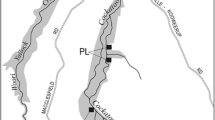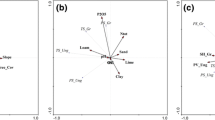Abstract
Bogs and fens are rare communities in the southern Appalachians of the USA. Many have been degraded, and little ecological information beyond cursory floral inventories is available to help guide conservation and restoration efforts. The seedling emergence technique was used to examine the soil seed banks of open and closed canopy regions of a southern mountain fen in North Carolina. We also examined the seed bank of an adjoining portion of the floodplain, which had been drained and cleared for a golf fairway and is now slated for restoration. A total of 32 taxa emerged, with graminoids (particularlyJuncus spp.) dominating all three seed banks. Seedlings were assigned to one of five plant types: woody, rush, sedge, grass, or forb. Significantly more woody seedlings emerged in soils from the closed canopy fen than in soils from the other two areas. Most rush seedlings emerged in open canopy fen soils, more sedge and forb seedlings emerged in floodplain soils, and more grass seedlings emerged in floodplain soils than in closed canopy fen soils. A discriminant function analysis separated the open canopy fen from the closed canopy fen and floodplain by seedlings of woody plants and rushes. The floodplain was separated from the open and closed regions of the fen by sedge and grass seedlings. These patterns in seed bank composition bore little similarity to the standing vegetation in the three areas. Restoration activities planned for the floodplain are intended to restore its hydrology and microtopography, which will strongly influence recruitment from the seed bank and surrounding seed sources.
Similar content being viewed by others
Literature Cited
Bierzychudek, P. 1982. Life histories and demography of shade-tolcrant temperate forest herbs: a review, New Phytologist 90:757–776.
Brown, D. 1992. Estimating the composition of a forest seed bank: a comparison of the seed extraction and seedling emergence methods. Canadian Journal of Botany 70:1603–1612.
Golet, F. C. 1969. Growth of muck-hardwoods in a New York waterfowl impoundment. M.S. Thesis. Cornell University, Ithaca, NY, USA.
Hanlon, T. J., C. E. Williams, and W. J. Moriarity. 1998. Species composition of soil seed banks of Allegheny Plateau riparian forests. Journal of the Torrey Botanical Society 125:199–215.
Leck, M. A. 1989. Wetland seed banks. p. 283–305.In M. A. Leck, V. T. Parker, and R. L. Simpson (eds.) Ecology of Soil Seed Banks. Academic Press, Inc., San Diego, CA, USA.
McGee, A. and M. C. Feller. 1993. Seed banks of forested and disturbed soils in southwestern British Columbia. Canadian Journal of Botany 71:1574–1583.
McGraw, J. B. 1987. Seed bank properties of an Appalachian sphagnum bog and a model of the depth distribution of viable seeds. Canadian Journal of Botany 65:2028–2035.
Moore, J. M. and R. W. Wein. 1977. Viable seed populations by soil depth and potential site recolonization after disturbance. Canadian Journal of Botany 55:2408–2412.
Moorhead, K. K. and I. M. Rossell. 1998. Southern mountain fens. p. 379–403.In M. G. Messina and W. H. Connor (eds.) Southern Forested Wetlands: Ecology and Management. CRC/Lewis Publishers, Boca Raton, FL, USA.
Paratley, R. D. and T. J. Fahey. 1986. Vegetation-environment relations in a conifer swamp in central New York. Bulletin of the Torrey Botanical Club 113:357–371.
Parker, V. T. and M. A. Leck. 1985. Relationships of seed banks to plant distribution patterns in a freshwater tidal wetland. American Journal of Botany 72:161–174.
Poiani, K. A. and P. M. Dixon, 1995. Seed banks of Carolina bays: potential contributions from surrounding landscape vegetation. American Midland Naturalist 134:140–154.
Poiani, K. A. and W. C. Johnson. 1988. Evaluation of the emergence method in estimating the seed bank composition of prairie wetlands. Aquatic Botany 32:91–97.
Radford, A. E., H. E. Ahles, and C. R. Bell. 1968. Manual of the Flora of the Carolinas. The University of North Carolina Press, Chapel Hill, NC, USA.
Rossell, C. R., Jr., I. M. Rossell, J. W. Petranka, and K. K. Moorhead. In press. Characteristics of a partially disturbed southern Appalachian forest-gap bog complex Virginia Museum of Natural History, Martinsville, VA, USA. Special Publication No. 3.
SAS Institute, Inc. 1990. SAS procedures guide. Version 6, 3rd edition. SAS Institute, Inc., Cary, NC, USA.
Schafale, M. P. and A. S. Weakley. 1990. Classification of the natural communities of North Carolina. 3rd Approximation, North Carolina Natural Heritage Program. North Carolina Department of Environment, Health, and Natural Resources, Raleigh, NC, USA.
Schneider, R. L. and R. R. Sharitz, 1986. Seed bank dynamics in a southeastern riverine swamp. American Journal of Botany 73: 1022–1030.
Tabachnik, B. G. and L. S. Fidell. 1989. Using Multivariate Statisties. 2nd ed. Harper & Row Publishers, Inc., NY, USA.
Titus, J. H. 1991. Seed bank of a hardwood floodplain swamp in Florida. Castanea 56:117–127.
United States Department of Agriculture. 1995. Preliminary draft soil survey of Graham County, North Carolina. Natural Resources Conservation Service, Asheville, NC, USA.
van der Valk, A. G. and C. B. Davis. 1976. The seed banks of prairie glacial marshes. Canadian Journal of Botany 54:1832–1838.
van der Valk, A. G., R. L. Pederson and C. B. Davis. 1992. Restoration and creation of freshwater wetlands using seed banks. Wetlands Ecology and Management 1:191–197.
van der Valk, A. G. and J. T. A. Verhoeven. 1988. Potential role of seed banks and understory species in restoring quaking fens from floating forests. Vegetatio 76:3–13.
Weakley, A. S. and M. P. Schafale. 1994. Non-alluvial wetlands of the southern Blue Ridge-diversity in a threatened ecosystem. Water, Air and Soil Pollution 77:359–383.
Williams, B. K. 1983. Some observations on the use of discriminant analysis in ecology. Ecology 64:1283–1291.
Wisheu, I. C. and P. A. Keddy. 1991. Seed banks of a rare wetland plant community: distribution patterns and effects of human-induced disturbance. Journal of Vegetation Science 2:181–188.
Author information
Authors and Affiliations
Rights and permissions
About this article
Cite this article
Rossell, I.M., Wells, C.L. The seed banks of a southern Appalachian fen and an adjacent degraded wetland. Wetlands 19, 365–371 (1999). https://doi.org/10.1007/BF03161768
Received:
Revised:
Accepted:
Issue Date:
DOI: https://doi.org/10.1007/BF03161768




